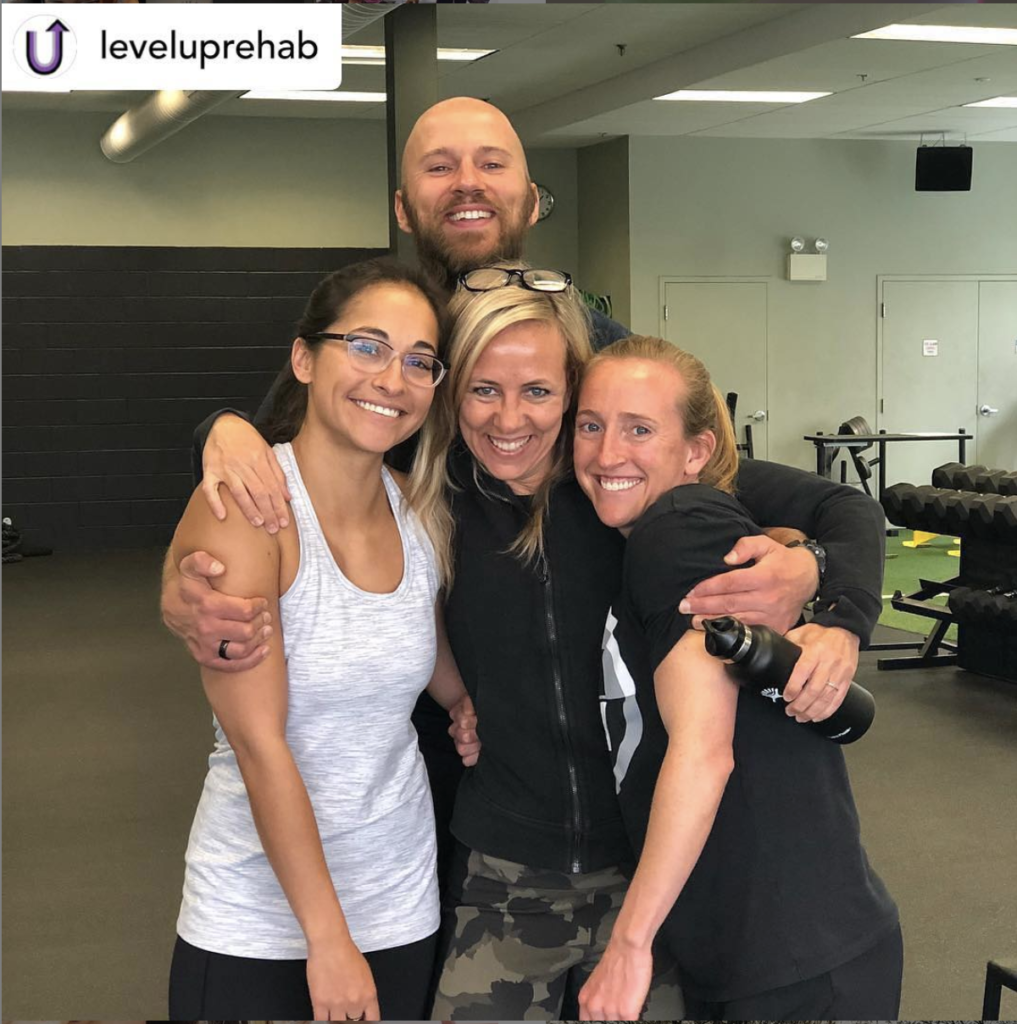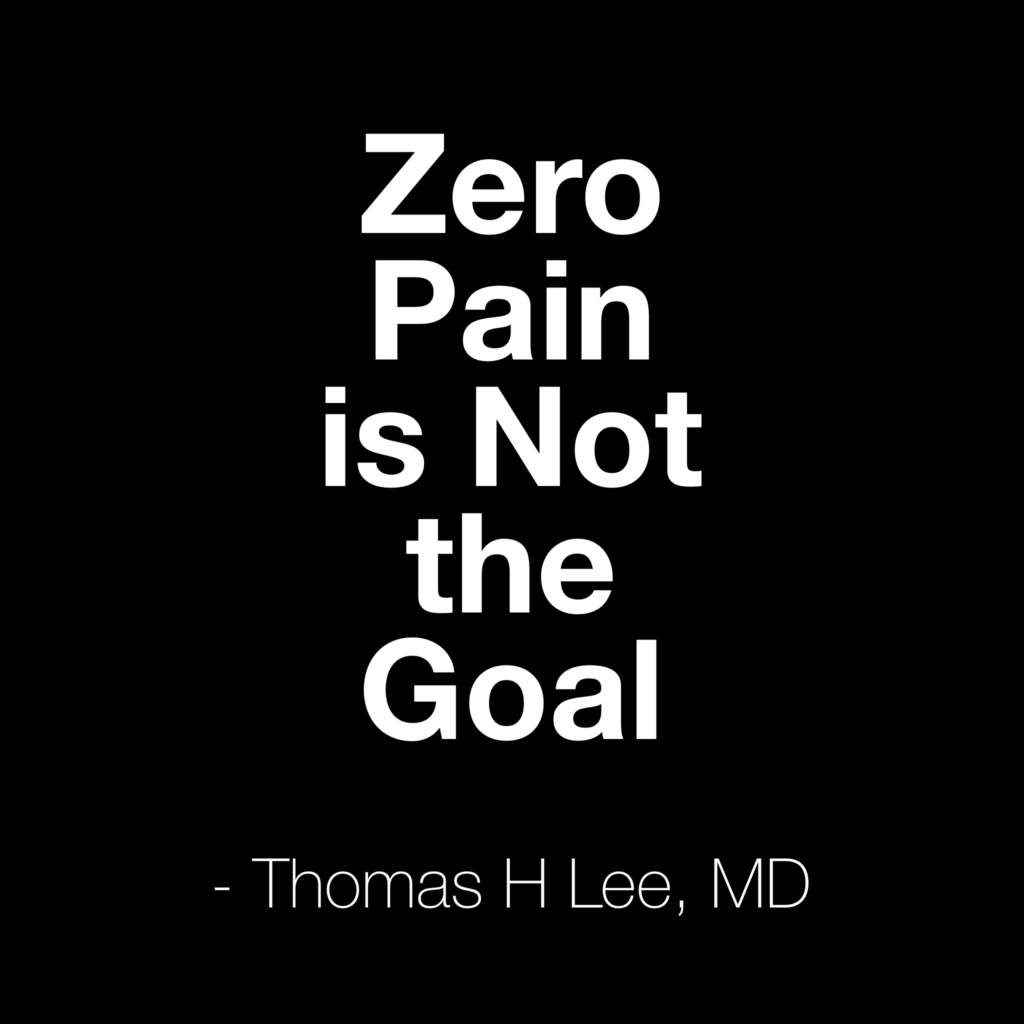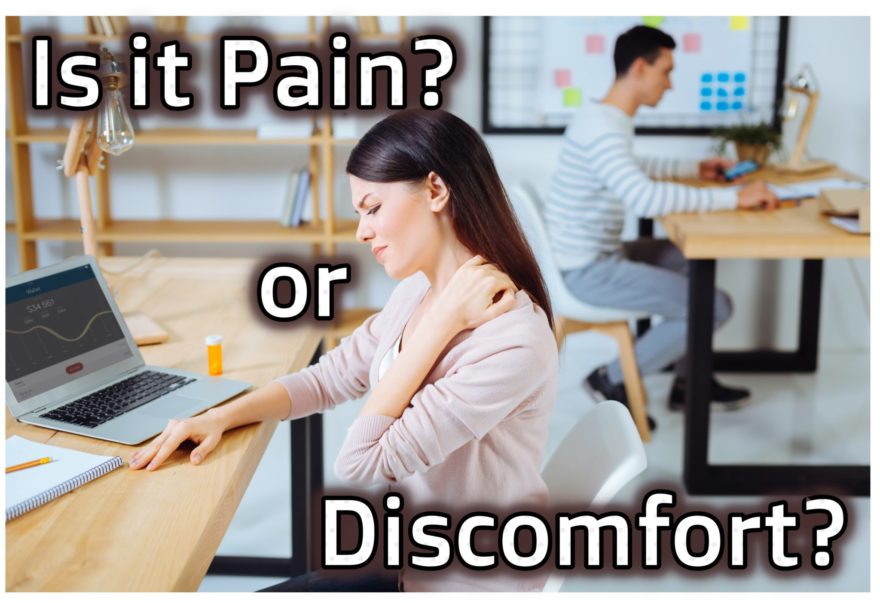Perhaps one of the biggest struggles we can run into in working with people in pain is getting our clients feeling safe when returning to movement.
The reality of the matter is that the chances of a person in pain experiencing some symptoms as he or she returns to activity is real and part of the process.
How can we get our people to trust the process? To be comfortable being uncomfortable?
I think Aline Thompson, a physical therapist I trust out of Denver, has the answer.

In today’s post, she outlines how changing the belief frame someone approaches pain with can have profound impacts on returning to life.
Without further adieu, here is what she has to say:
Table of Contents
Is there a Difference Between Pain and Discomfort?
There’s a difference and it matters.
More often than not the question goes more like this: “Tell me about your pain…”
After which you get a pause, with a look of contemplation. When this happens I wonder; what are they thinking? Should that silence be filled with a follow up question?
“…. Or is it discomfort?”
When I ask folks whether there is a difference between pain and discomfort everyone says yes. When I ask how they differ these are the answers:
“Pain is discouraging, Discomfort is just frustrating”
–
“Discomfort is annoying but you can ignore it. Pain interferes with your brain and thought processes. You can’t do a complex math problem easily when you’re in pain”
–
“Pain can hinder progress but you have to be ok with some discomfort to make progress. “
–
“I don’t always love discomfort but I’m not scared of it like pain.”
Many think of discomfort as pain of a lower intensity (mild pain) or as a transition point from non-painful to painful. But discomfort doesn’t necessarily have to be described in relation to pain. It can be an independent construct.

When considering a difference, the person experiencing the sensation decides. In the context of rehab and training, imbedded in the question “Is it pain or is it discomfort?” is a different question: “Is it safe?”
Why is this a question worth asking? Here are a variety of reasons to consider:
Self-Efficacy
Self-efficacy is an individual’s belief in their innate ability to achieve goals. Wikipedia describes it as a personal judgment of “how well one can execute courses of action required to deal with prospective situations.”¹ Albert Bandura, who developed this concept within psychology, defines self-efficacy as “a resilient belief system.”
As a predictor of positive treatment outcomes and healthy behavior, self-efficacy is what you want to promote with your patients and clients. You can even measure it with the Pain self-efficacy questionnaire².
In order to achieve positive goals over time, you need to believe you have the power to effect change in your life. This self-belief is more important than fears and false beliefs about movement³! The ability to distinguish between pain and discomfort promotes self-efficacy.

Positive attitudes and beliefs fostered by self-efficacy are influenced by an individual’s expectations. Do they expect to have pain every time they bend over? Will rehab post-surgery be pain-free? Can any type of personal best be achieved without some discomfort along the way?
So what exactly are realistic expectations?
Realistic Expectations
I spent years thinking I should help my patients eliminate pain from their lives. All of the goals I wrote centered on achieving 0/10 pain. In the back of my head I often wondered if this was realistic but in the moment (actually for several years) I over-treated pain.
In his editorial “Zero Pain is Not the Goal”, Thomas H. Lee argues for reduction of suffering as the goal of medicine. Reduced suffering is “something more complex than analgesia alone” and not dependent on elimination of pain4.

This is an important point for both the short term and potentially the long term. While some patients may experience abolition of their pain this doesn’t always happen and these individuals still need to thrive.
The zero pain mindset has been around for a long time and involves deeply held beliefs. I believe ours need adjusting.
Change Beliefs
When it comes to pain there are several myths that need updating:
- Pain is always bad
- You have to have a 0/10 pain level before you resume activity
- Once you have pain with an activity, you always will
Changing beliefs is SUPER difficult. Language can be a reflection of your belief system. By implementing the use of “discomfort” as an alternative to “pain” we can encourage one to reflect on whether a sensation might be less threatening.
For example:
- Discomfort is often needed for growth and progress
- You will likely feel discomfort when resuming an activity
- Returning to an activity that was painful might initially feel uncomfortable
To change beliefs we need to change OUR collective story: mine, yours, ours. We need to talk about it.
New Language = Better Communication
In her essay “On Being Ill” Virginia Wolf describes the “poverty of language” with regards to illness5. She contends the expression of love comes more readily to us than the narrative of pain.
Ask someone to describe their symptoms and it’s common for them to struggle finding the words. This strain is significant because words are how we attach meaning to our experience and how we attempt to share that experience with others.
Language is more than a medium for communication. Words represent concepts, emotions, and beliefs. Just as emotions and thoughts influence pain so can language.

Several studies have demonstrated the correlation between the processing of pain-related words and increased activity of the pain matrix in the brain on brain fMRI6,7.
The relationship between affect and language can be seen with word choice describing not only physical symptoms but emotional as well8. Most people would agree that the perception of the word PAIN has more of a negative connotation than DISCOMFORT.
It makes sense that we can therefore minimize pain-catastrophizing by offering less threatening terminology.
Knowing that words do more than describe reality, we can use language to create reality. Statements like “sore but safe” and “hurt doesn’t equal harm” convey a concept. Questions like “Is it pain or discomfort?” prompt one to actively participate in the discussion and explore.
Words are the starting point to changing the experience but we need to connect new terminology to action.
Adaptation
Adaptation is the name of the game when it comes to getting better.
The SAID (Specific Adaptation to Imposed Demand) principle states that humans will adapt to the specific stressors imposed on them. This is the crux of the logic behind both graded exposure and hormesis—the real goods of a quality rehab or training program.
Graded exposure is the approach we most associate in PT with regards to patients with persistent pain. Graded exposure therapy, as it applies to rehab, involves the progressive introduction to activities and exercise.
While we refer to graded exposure mostly with rehab clients, it is simply a form of hormesis and graded activity has widespread applications. Hormesis, the process of dosing stress to result in positive outcomes is the foundation of many health and wellness interventions.
Call it what you want. In order to change someone’s sensitivity to pain and stress you have to expose them to experiences in the DISCOMFORT ZONE.
How do you decide what that zone is?

Decision-Making
Distinguishing between pain and discomfort can help you and your patient/client make decisions about progressing, regressing and modifying the exercises or activities you are doing.
“Is it pain or is it discomfort?” can become a framework they continue with in life when they aren’t under your care.
How do you do this?
Much like the pain intensity tools of the Numeric Pain Scale (NPS) or the Visual Analog Scale (VAS) we can develop a discomfort scale. In fact this has already been proposed and investigated, with initial results demonstrating that a VAS-D (discomfort scale) is a valid tool. This study also shows discomfort emerges as an independent construct from pain9.
A discussion that distinguishes between pain and discomfort should ultimately evolve into a discussion on how much discomfort is ok? Establishing an individualized discomfort threshold is a simple and straightforward communication tool. As tolerance increases we expect this threshold to change over time.
Conclusion
Let’s rethink the way we ask people about their pain. We empower patients and clients in many ways: movement awareness, exercise for specific goals, coping and recovery strategies, self-care and knowledge. How about also offering up a different lexicon?
Alternative words with which to think of their pain and symptoms can help mitigate fear avoidance without lengthy, complex explanations. The goal after all is relief of suffering, followed by development of resilience. Normalizing discomfort is the path. It starts with you.
How do you help your people get comfortable with discomfort? Comment below and let the fam know!
About Aline

Aline Thompson obtained her B.A in biology from Kenyon College and both her Masters of Science and Doctor of Physical Therapy degrees from Arcadia University. Over the last 20+ years, she has worked exclusively in outpatient orthopedics seeing a wide variety of patients. As a lifelong learner, Aline has a broad background in clinical skills; having attended numerous continuing education seminars. She started her cash PT business, Level Up Rehab, in 2017, and employs a ‘whole’ person approach to assessment with highly individualized care.
If you want to learn more from Aline (which I strongly suggest), you can find her in the following spots:
Her website, Level Up Physical Therapy
Instagram: @leveluprehab
Facebook: Aline.Thompson.714
Twitter: @lhompsonaline
Email: Aline@leveluprehab.com
References
- Wikipedia : self-efficacy
- Costal, L. d., Maherl, C. G., McAuleyl, J. H., Hancockl, M. J. and Smeetsl, R. J. (2011), Self‐efficacy is more important than fear of movement in mediating the relationship between pain and disability in chronic low back pain. European Journal of Pain, 15: 213-219.
- Nicholas, M. K. (2007), The pain self‐efficacy questionnaire: Taking pain into account. European Journal of Pain, 11: 153-163.
- Lee TH. Zero Pain Is Not the Goal. JAMA. 2016;315(15):1575–7.
- On Being Ill by Virginia Woolf
- Richter, Maria & Eck, Judith & Straube, Thomas & Miltner, Wolfgang & Weiss, Thomas. (2009). Do words hurt? Brain activation during the processing of pain-related words. Pain. 148. 198-205.
- Ritter A, Franz M, Puta C, Dietrich C, Miltner WH, Weiss T. Enhanced Brain Responses to Pain-Related Words in Chronic Back Pain Patients and Their Modulation by Current Pain. Healthcare (Basel). 2016;4(3):54.
- Borelli E, Crepaldi D, Porro CA, Cacciari C. The psycholinguistic and affective structure of words conveying pain. PLoS One. 2018;13(6)
- Harland, Nicholas, Ryand, Cormac. 2019), “It’s Not Pain It’s Discomfort”: Development and Investigation of a Discomfort Measurement Scale. Pain and Rehabilitation – the Journal of Physiotherapy Pain Association, 46:19-23
All images aside from the cover photo are from Pixabay

